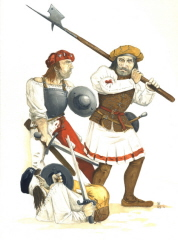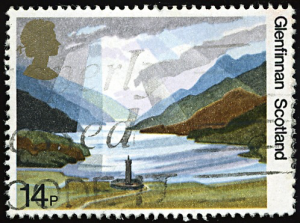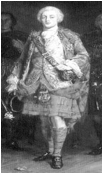April 29th Scots Book of Days
April 29 1380 Catherine of Siena, Teacher of the Faith,
1520 Cleanse the Causeway, High Street Edinburgh, between Archibald 6th Earl of Angus (clan Douglas) who slew Sir Patrick Hamilton, Arran’s brother, and Arran’s (clan Hamilton) party routed. Anderson Scot’s History v. 2/p. 46.[Hamilton 2Stewart 2Millar 2simmons 2Choate 2Sorensen]  According to Robert Lindsay of Pitscottie in his history written in 1575, each man was: ‘well accompanied and arrayed with jack and speir’ Gawain Douglas, Archbishop of Dunkeld was placed in the role of peacekeeper and negotiator mainly due to his pious and caring nature. He called upon Archbishop James Beaton, latterly a Hamilton supporter and great friend of Gawain, to remonstrate with his allies and as a fellow churchmen and official representative of the law, sue for a peaceful settlement. They met at Blackfriars Wynd to discuss a suitable course of action.
According to Robert Lindsay of Pitscottie in his history written in 1575, each man was: ‘well accompanied and arrayed with jack and speir’ Gawain Douglas, Archbishop of Dunkeld was placed in the role of peacekeeper and negotiator mainly due to his pious and caring nature. He called upon Archbishop James Beaton, latterly a Hamilton supporter and great friend of Gawain, to remonstrate with his allies and as a fellow churchmen and official representative of the law, sue for a peaceful settlement. They met at Blackfriars Wynd to discuss a suitable course of action.
However Beaton had resigned himself to confrontation and met Douglas wearing a mail haulberk under his robes. He was at once quizzed by Douglas about the imminent debacle and declared ‘upon my conscience I know nothing of this.’ And as to show his honor he struck his breast with his fist causing the chainmail to rattle. Douglas, now aware that Beaton was armored ready for the fight, sourly remarked ‘My Lord your conscience clatters! ’ The locals christened the event the ‘ Clense the Calsey’ most likely after the battle cry of the Douglas faction www.bolb.org.uk
1697 sometime in. Failed harvest, severe famine, 5-15 percent starved to death. The seven ill years was a period of national famine in Scotland in the 1690s, by four years of failed harvests (1695, 1696 and 1698–99). Before the seventeenth century, with difficult terrain, poor roads and methods of transport, there was little trade between different areas of Scotland. Most settlements depended for subsistence on what was produced locally, often with very little in reserve in bad years. Most farming was based on the lowland fermtoun or highland baile, settlements of a handful of families that jointly farmed an area notionally suitable for two or three plough teams. These were allocated in run rigs, of “runs” (furrows) and “rigs” (ridges), to tenant farmers.[1] Those with property rights included husbandmen, lesser landholders and free tenants.[2] Below them were the cottars, who often shared rights to common pasture, occupied small portions of land and participated in joint farming as hired labor. Farms also might have grassmen, who had rights only to grazing.[2] There were also large numbers of casual wage laborers who carried out basic agricultural work. Laborers on fixed incomes, along with pensioners, were particularly vulnerable to the impact of famine, but it also affected those with land, who could not save enough seed for future planting and feed their families. Even pastoral farmers were affected as the price of animal feed became unaffordable. Wikipedia.
1719 sometime late April. William Mackenzie, 5th Earl of Seaforth (Scottish Gaelic: Uilleam Dubh Shìophort), who was chief of the Clan Mackenzie; the Earl Marischal; and the Marquess of Tullibardine; and some Irish officers, a few hundred Highlanders, including members of the Clan MacRae, Robert Roy MacGregor, and a party of other MacGregors, join Spaniards at Castle of Eilean Donan. The main body of the troop went south to stir up the Highlanders, leaving a small garrison (40-50 men) at the castle. The Jacobite forces were to be led by the Earl of Seaforth and also John Cameron of Lochiel, 18th Captain and Chief of Clan Cameron; along with Lord George Murray. Their plan of action was to capture Inverness. War of the Quadruple Alliance
 Macrae Crest: A cubit arm grasping a sword all Proper. Motto: FORTITUDINE
[from Latin: “With fortitude”].
Badge: club moss. Club moss sometimes referred to as staghorn grass, may refer to the Mackenzie chiefly arms, or at least the Macrae’s close association with the Mackenzies.
Macrae Crest: A cubit arm grasping a sword all Proper. Motto: FORTITUDINE
[from Latin: “With fortitude”].
Badge: club moss. Club moss sometimes referred to as staghorn grass, may refer to the Mackenzie chiefly arms, or at least the Macrae’s close association with the Mackenzies.
1715 and 1745. The Jacobite risings. The uprising in 1715 in support of the claim of the auld Pretender against the Hanoverian regime had support amongst some members of the University. Alexander Robertson of Struan ‘most persistent of all Jacobites’ (Cant) had been a student. Another former student, the Chancellor’s son Tullibardine, was out in the ’15 and raised the standard of Bonnie Prince Charlie at Glenfinnan in 1745.
Another former student, the Chancellor’s son Tullibardine, was out in the ’15 and raised the standard of Bonnie Prince Charlie at Glenfinnan in 1745.
Young Simon Fraser of Lovat left his studies to lead his clan in support of the Stuarts. The term Jacobite came from Jacob, the James name being substituted for Jacob, in the English translation of the Bible New Testament. James 2nd (of England) had fathered two Queens Mary and Ann, and The Old Pretender who father Bonnie Prince Charlie, The Young Pretender.
 Fraser of Lovat Crest: A buck’s head erased Proper. Motto: JE SUIS PREST.
[From French: “I am ready”]. Chief: Simon Fraser, 18th Lord Lovat
Fraser of Lovat Crest: A buck’s head erased Proper. Motto: JE SUIS PREST.
[From French: “I am ready”]. Chief: Simon Fraser, 18th Lord Lovat
St Leonard’s College in particular saw Jacobite protests in 1718-19 which brought a Parliamentary commission to visit the University. Once the rebels were defeated at Culloden and scattered, captured and their estates forfeited, the University made clear where its loyalties lay. It chose the Duke of Cumberland as its Chancellor in 1746. In an effort to prevent any recurrence of such Jacobite activity as had been seen in 1689, 1708, 1715, and 1719 ‘Butcher Cumberland’, who had commanded the loyalist army, had authorized the atrocities committed against the Highlanders in the aftermath of the battle of Culloden.
 Charles Edward Stuart, (“Young Pretender” or Bonnie Prince Charlie) was born in Rome, 1720–1788), the grandson of deposed king James II of England (James VII of Scotland) and the son of the “Old Pretender,” James Stuart. In 1745 he made an attempt to reclaim the throne. He became a fugitive. After several months on the run, Flora McDonald smuggled him to the island of Skye and from there he made his way safely to France.
Charles Edward Stuart, (“Young Pretender” or Bonnie Prince Charlie) was born in Rome, 1720–1788), the grandson of deposed king James II of England (James VII of Scotland) and the son of the “Old Pretender,” James Stuart. In 1745 he made an attempt to reclaim the throne. He became a fugitive. After several months on the run, Flora McDonald smuggled him to the island of Skye and from there he made his way safely to France.
 1785 sometime in the year. Emma Lady Hamilton,
1785 sometime in the year. Emma Lady Hamilton,
Emma by George Romney, circa 1785.
1806 Lord Melville tried (eventually acquitted) before the House of Lords. Melville was first Lord of the Admiralty under Pitt. Tytler’s Britannica.
1824 Five executed for high treason for conspiracy against the ministers who were assembled at a cabinet dinner at Lord Harrowby’s. Thistlewood was the leader, meeting in a hay loft on Cato Street. Tytler’s History of Scotland at Britannica.
1940 Submarine “UNITY” was lost in collision with a Norwegian merchantman off the northeast coast of England. Monthly Loss Summary 54 British, Allied and neutral ships of 134,000 tons from all causes.
- Hi I’m Tom – People. I’m from falkirk (Scotland).I play Rugby, and I’m serving in London south mission and I’m a Mormon! Hi I’m Tom I’m from Scotland, I am currently serving my mission in the London south mission, I enjoy playing rugby, I like music. I can cook which is a good thing.
https://www.mormon.org/me/CR5V/Tom
Disclaimer: The author of each article published on this web site owns his or her own words. The opinions, beliefs and viewpoints expressed by the various authors and forum participants on this site do not necessarily reflect the opinions, beliefs and viewpoints of Utah Standard News or official policies of the USN and may actually reflect positions that USN actively opposes.
© No claim in public domain or fair use.
Utah Standard News depends on the support of readers like you.
Good Journalism requires time, expertise, passion and money. We know you appreciate the coverage here. Please help us to continue as an alternative news website by becoming a subscriber or making a donation. To learn more about our subscription options or make a donation, click here.
To Advertise on UtahStandardNews.com, please contact us at: ed@utahstandardnews.com.


Comments - No Responses to “April 29th Scots Book of Days”
Sure is empty down here...